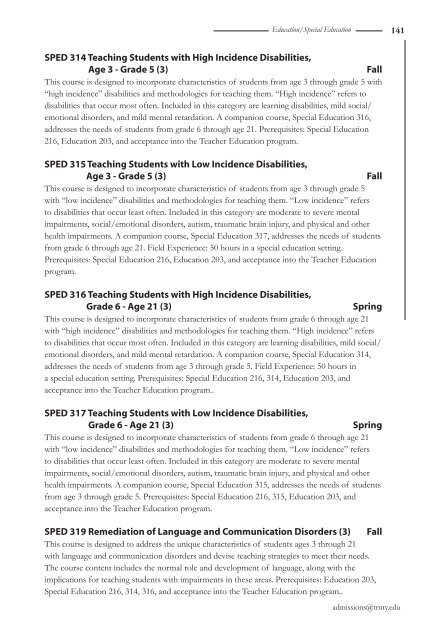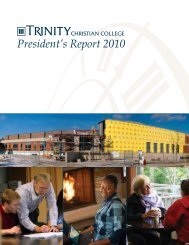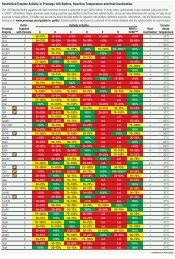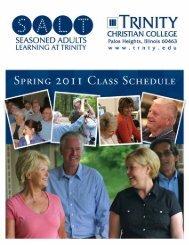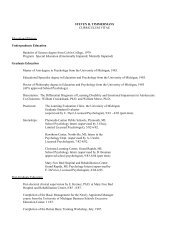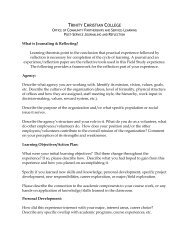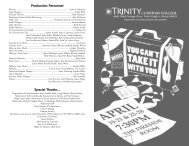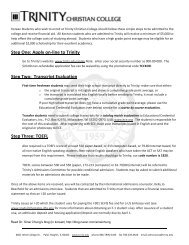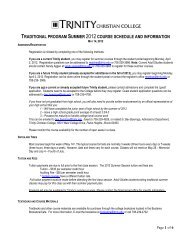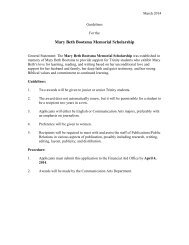College's catalog - Trinity Christian College
College's catalog - Trinity Christian College
College's catalog - Trinity Christian College
You also want an ePaper? Increase the reach of your titles
YUMPU automatically turns print PDFs into web optimized ePapers that Google loves.
Education/Special Education<br />
141<br />
SPED 314 Teaching Students with High Incidence Disabilities,<br />
Age 3 - Grade 5 (3)<br />
Fall<br />
This course is designed to incorporate characteristics of students from age 3 through grade 5 with<br />
“high incidence” disabilities and methodologies for teaching them. “High incidence” refers to<br />
disabilities that occur most often. Included in this category are learning disabilities, mild social/<br />
emotional disorders, and mild mental retardation. A companion course, Special Education 316,<br />
addresses the needs of students from grade 6 through age 21. Prerequisites: Special Education<br />
216, Education 203, and acceptance into the Teacher Education program.<br />
SPED 315 Teaching Students with Low Incidence Disabilities,<br />
Age 3 - Grade 5 (3)<br />
Fall<br />
This course is designed to incorporate characteristics of students from age 3 through grade 5<br />
with “low incidence” disabilities and methodologies for teaching them. “Low incidence” refers<br />
to disabilities that occur least often. Included in this category are moderate to severe mental<br />
impairments, social/emotional disorders, autism, traumatic brain injury, and physical and other<br />
health impairments. A companion course, Special Education 317, addresses the needs of students<br />
from grade 6 through age 21. Field Experience: 50 hours in a special education setting.<br />
Prerequisites: Special Education 216, Education 203, and acceptance into the Teacher Education<br />
program.<br />
SPED 316 Teaching Students with High Incidence Disabilities,<br />
Grade 6 - Age 21 (3)<br />
Spring<br />
This course is designed to incorporate characteristics of students from grade 6 through age 21<br />
with “high incidence” disabilities and methodologies for teaching them. “High incidence” refers<br />
to disabilities that occur most often. Included in this category are learning disabilities, mild social/<br />
emotional disorders, and mild mental retardation. A companion course, Special Education 314,<br />
addresses the needs of students from age 3 through grade 5. Field Experience: 50 hours in<br />
a special education setting. Prerequisites: Special Education 216, 314, Education 203, and<br />
acceptance into the Teacher Education program..<br />
SPED 317 Teaching Students with Low Incidence Disabilities,<br />
Grade 6 - Age 21 (3)<br />
Spring<br />
This course is designed to incorporate characteristics of students from grade 6 through age 21<br />
with “low incidence” disabilities and methodologies for teaching them. “Low incidence” refers<br />
to disabilities that occur least often. Included in this category are moderate to severe mental<br />
impairments, social/emotional disorders, autism, traumatic brain injury, and physical and other<br />
health impairments. A companion course, Special Education 315, addresses the needs of students<br />
from age 3 through grade 5. Prerequisites: Special Education 216, 315, Education 203, and<br />
acceptance into the Teacher Education program.<br />
SPED 319 Remediation of Language and Communication Disorders (3) Fall<br />
This course is designed to address the unique characteristics of students ages 3 through 21<br />
with language and communication disorders and devise teaching strategies to meet their needs.<br />
The course content includes the normal role and development of language, along with the<br />
implications for teaching students with impairments in these areas. Prerequisites: Education 203,<br />
Special Education 216, 314, 316, and acceptance into the Teacher Education program..<br />
admissions@trnty.edu


